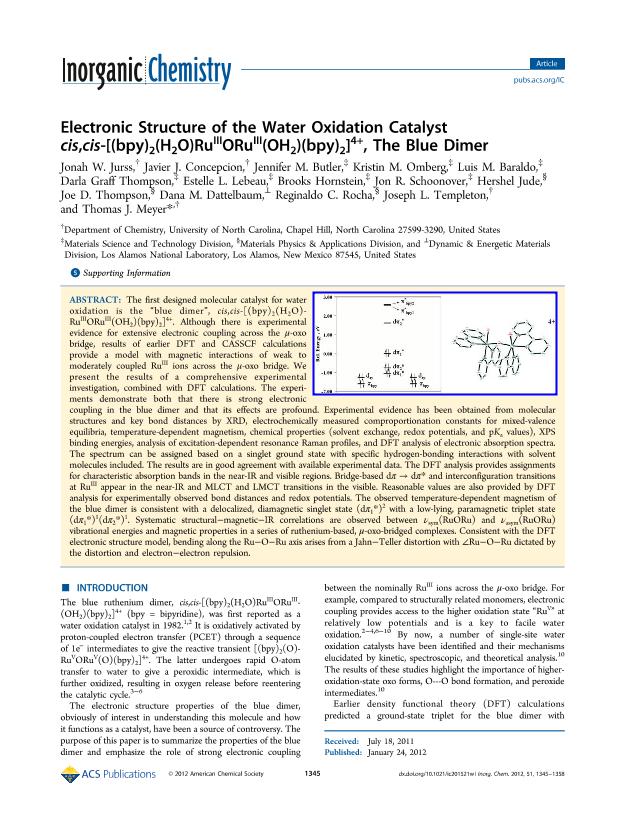Artículo
Electronic structure of the water oxidation catalyst cis, cis -[(bpy) 2(H 2O)Ru IIIORu III(OH 2)(bpy) 2] 4+, the blue dimer
Jurss, Jonah W.; Concepcion, Javier J.; Butler, Jennifer M.; Omberg, Kristin M.; Baraldo Victorica, Luis Mario ; Thompson, Darla Graff; Lebeau, Estelle L.; Hornstein, Brooks; Schoonover, Jon R.; Jude, Hershel; Thompson, Joe D.; Dattelbaum, Dana M.; Rocha, Reginaldo C.; Templeton, Joseph L.; Meyer, Thomas J.
; Thompson, Darla Graff; Lebeau, Estelle L.; Hornstein, Brooks; Schoonover, Jon R.; Jude, Hershel; Thompson, Joe D.; Dattelbaum, Dana M.; Rocha, Reginaldo C.; Templeton, Joseph L.; Meyer, Thomas J.
 ; Thompson, Darla Graff; Lebeau, Estelle L.; Hornstein, Brooks; Schoonover, Jon R.; Jude, Hershel; Thompson, Joe D.; Dattelbaum, Dana M.; Rocha, Reginaldo C.; Templeton, Joseph L.; Meyer, Thomas J.
; Thompson, Darla Graff; Lebeau, Estelle L.; Hornstein, Brooks; Schoonover, Jon R.; Jude, Hershel; Thompson, Joe D.; Dattelbaum, Dana M.; Rocha, Reginaldo C.; Templeton, Joseph L.; Meyer, Thomas J.
Fecha de publicación:
02/2012
Editorial:
American Chemical Society
Revista:
Inorganic Chemistry
ISSN:
0020-1669
Idioma:
Inglés
Tipo de recurso:
Artículo publicado
Clasificación temática:
Resumen
The first designed molecular catalyst for water oxidation is the "blue dimer", cis,cis-[(bpy) 2(H 2O)Ru IIIORu III(OH 2)(bpy) 2] 4+. Although there is experimental evidence for extensive electronic coupling across the μ-oxo bridge, results of earlier DFT and CASSCF calculations provide a model with magnetic interactions of weak to moderately coupled Ru III ions across the μ-oxo bridge. We present the results of a comprehensive experimental investigation, combined with DFT calculations. The experiments demonstrate both that there is strong electronic coupling in the blue dimer and that its effects are profound. Experimental evidence has been obtained from molecular structures and key bond distances by XRD, electrochemically measured comproportionation constants for mixed-valence equilibria, temperature-dependent magnetism, chemical properties (solvent exchange, redox potentials, and pK a values), XPS binding energies, analysis of excitation-dependent resonance Raman profiles, and DFT analysis of electronic absorption spectra. The spectrum can be assigned based on a singlet ground state with specific hydrogen-bonding interactions with solvent molecules included. The results are in good agreement with available experimental data. The DFT analysis provides assignments for characteristic absorption bands in the near-IR and visible regions. Bridge-based dπ → dπ* and interconfiguration transitions at Ru III appear in the near-IR and MLCT and LMCT transitions in the visible. Reasonable values are also provided by DFT analysis for experimentally observed bond distances and redox potentials. The observed temperature-dependent magnetism of the blue dimer is consistent with a delocalized, diamagnetic singlet state (dπ 1*) 2 with a low-lying, paramagnetic triplet state (dπ 1*) 1(dπ 2*) 1. Systematic structural-magnetic-IR correlations are observed between ν sym(RuORu) and ν asym(RuORu) vibrational energies and magnetic properties in a series of ruthenium-based, μ-oxo-bridged complexes. Consistent with the DFT electronic structure model, bending along the Ru-O-Ru axis arises from a Jahn-Teller distortion with Ru-O-Ru dictated by the distortion and electron-electron repulsion. © 2012 American Chemical Society.
Palabras clave:
Catalysis
,
Reaction Kinetics
,
Inorganic Reaction Mechanisms
Archivos asociados
Licencia
Identificadores
Colecciones
Articulos(INQUIMAE)
Articulos de INST.D/QUIM FIS D/L MATERIALES MEDIOAMB Y ENERGIA
Articulos de INST.D/QUIM FIS D/L MATERIALES MEDIOAMB Y ENERGIA
Citación
Jurss, Jonah W.; Concepcion, Javier J.; Butler, Jennifer M.; Omberg, Kristin M.; Baraldo Victorica, Luis Mario; et al.; Electronic structure of the water oxidation catalyst cis, cis -[(bpy) 2(H 2O)Ru IIIORu III(OH 2)(bpy) 2] 4+, the blue dimer; American Chemical Society; Inorganic Chemistry; 51; 3; 2-2012; 1345-1358
Compartir
Altmétricas



